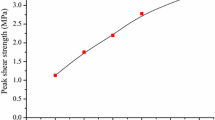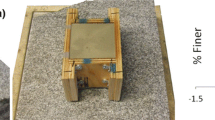Abstract
In most cases, the behaviour of rock masses is dominated by weak planes such as joints, along which shear is more likely to occur and deformation is usually nonlinear. Thus, it is of great significance to understand the shear process and mechanisms of joints. We investigated the shear process and mechanics of joints with regular and irregular triangular asperities through a series of direct shear tests, where a high-speed camera was used to record the deformation and failure of asperities. It was found that, for joints with regular asperities, the nonlinear shear behaviour is mainly related to shear failure of asperities. For joints with irregular asperities, this nonlinearity results from both shear failure of asperities and the interactions between them. Based on the findings, it was assumed that the shear stiffness/strength of a joint is the sum of shear stiffness/strength of individual asperities. By this assumption, estimation methods were developed to predict shear strength, shear displacement, and shear stiffness of joints with irregular asperities. A one-dimensional elastoplastic model was then put forward to describe the nonlinear shear behaviour of the irregular joints. In this model, a spring element is connected in series with a modified Saint Venant element. Different from the traditional Saint Venant element, this modified one incorporates the concept of alterable yield limit and thus can reflect the evolution of shear stiffness during shearing. Eventually, with these estimation methods and this new elastoplastic model, the nonlinear shear process of the joints could be expressed mathematically. The applicability of this model was verified through the comparison between fitting results and laboratory measurements. Our findings could provide insights into the evolution of shear stiffness and help to gain a better understanding on the shear process of rough joints.


















Similar content being viewed by others
Abbreviations
- \(\tau _{{{\text{initial}}}}^{{\text{*}}}\) :
-
Initial yield limit on shear stress–displacement curves
- \({u_{\text{T}}}\) :
-
Shear displacement of joint
- \({u_i}\) :
-
Shear displacement of each asperity
- \({k_i}\) :
-
Shear stiffness of each asperity
- \({k_{{\text{joint}}}}\) :
-
Shear stiffness of joint
- \(M\) :
-
The number of asperities on joint
- \({k_{{\text{lin}}}}\) :
-
Linear shear stiffness on shear stress–displacement curves
- \({u_{{\text{yield}}}}\) :
-
Shear displacement at initial yielding strength
- \({u_{{\text{peak}}}}\) :
-
Shear displacement at peak strength
- \({\tau _{{\text{peak~}}}}\) :
-
Peak strength of joint
- \({\tau _{{\text{residual}}}}\) :
-
Residual shear strength of joint
- \(\sigma\) :
-
Normal stress
- \({f_{{\text{re}}}}\) :
-
Residual frictional coefficient
- \(C\) :
-
Apparent cohesion of joint
- \({\text{d}}{\tau _{\text{H}}}\) :
-
Stress increment in Hooke’s element
- \({\text{d}}{u_{\text{H}}}\) :
-
Displacement increment in Hooke’s element
- \({k_1}\) :
-
Spring stiffness in Hooke’s element
- \({k_2}\) :
-
Spring stiffness in St.V or M_St.V element
- \({\tau ^*}\) :
-
Yield limit of St.V model or M_St.V element
- \(\Delta l\) :
-
Pre-deformation of a spring in St.V or M_St.V element
- \(\psi\) :
-
Friction angle in St.V or M_St.V element
- \({\text{d}}{\tau _{{\text{M}}\_{\text{S}}}}\) :
-
Stress increment in M_St.V element
- \({\text{d}}{u_{{\text{M}}\_{\text{S}}}}\) :
-
Displacement increment in M_St.V element
- \(\theta\) :
-
Dip angle of frictional surfaces in M_St.V element
- \({\text{d}}{\tau _{\text{T}}}\) :
-
Total stress increment in H-M_St.V model.
- \({\text{d}}{u_{\text{T}}}\) :
-
Total displacement increment in H-M_St.V model
- \({k_{\text{e}}}\) :
-
Elastic stiffness in the H-M_St.V model
- \({k_{\text{p}}}\) :
-
“Plastic stiffness” in the H-M_St.V model
- \({k_{\text{I}}}\) :
-
Total stiffness of the H-M_St.V model-I
- \({k_{{\text{II}}}}\) :
-
Total stiffness of the H-M_St.V model-II
- \({a_{\text{h}}}\) :
-
The projected length of shear stress–displacement curve in hardening phase
- \({a_{\text{s}}}\) :
-
The projected length of shear stress–displacement curve in softening phase
- \({a_{{\text{l-e}}}}\) :
-
The extended shear displacement in the linear elastic phase
- \({A_{\text{h}}}\) :
-
The empirical constant in the hardening phase
- \({A_{\text{s}}}\) :
-
The empirical constant in the softening phase
- \(\Delta {u_{\text{h}}}\) :
-
Relative shear displacement in hardening phase
- \(\Delta {u_{\text{s}}}\) :
-
Relative shear displacement in softening phase
References
Al-Bender F (2010) Fundamentals of friction modeling. In: Proceedings of the ASPE Spring topical meeting on control of precision systems, MIT, April 11–13, 2010. ASPE-The American Society of precision Engineering, pp 117–122
Bandis S, Lumsden AC, Barton NR (1981) Experimental studies of scale effects on the shear behaviour of rock joints. Int J Rock Mech Min Sci Geomech Abstr 18(1):1–21
Bandis SC, Lumsden AC, Barton NR (1983) Fundamentals of rock joint deformation. Int J Rock Mech Min Sci Geomech Abstr 20(6):249–268
Desai CS (1985) Cyclic testing and modeling of interfaces. J Geotech Eng 111(6):793–815
Desai CS, Ma Y (1992) Modelling of joints and interfaces using the disturbed-state concept. Int J Numer Anal Methods Geomech 16(9):623–653
Ghaboussi J, Wilson EL, Isenberg J (1973) Finite element for rock joints and interfaces. J Soil Mech Found Div 99(1):849–862
Grasselli G, Wirth J, Egger P (2002) Quantitative three-dimensional description of a rough surface and parameter evolution with shearing. Int J Rock Mech Min Sci 39(6):789–800
Haberfield CM, Johnston IW (1994) A mechanistically-based model for rough rock joints. Int J Rock Mech Min Sci Geomech Abstr 31(4):279–292
Heuze FE, Barbour TG (1982) New models for rock joints and interfaces. J Geotech Eng 180(5):757–776
Hutson RW, Dowding CH (1990) Joint asperity degradation during cyclic shear. Int J Rock Mech Min Sci Geomech Abstr 27(2):109–119
Jaeger JC, Cook N, Zimmerman RW (2007) Fundamentals of rock mechanics, 4th edn. Blackwell Publishing, Oxford
Jiang Y, Li B, Tanabashi Y (2006) Estimating the relation between surface roughness and mechanical properties of rock joints. Int J Rock Mech Min Sci 43(6):837–846
Jing LA (1990) Two-dimensional constitutive model of rock joints with pre- and post-peak behaviour. In: International symposium on rock joints. Balkema, Loen, Norway, pp 633–638
Johnston IW, Lam TSK (1989) Shear behaviour of regular triangular mortar/rock joints—analysis. J Geotech Eng 115(5):711–727
Kulhawy FH (1975) Stress deformation properties of rock and rock discontinuities. Eng Geol 9(4):327–350
Leong E, Randolph M (1992) A model for rock interfacial behaviour. Rock Mech Rock Eng 25(3):187–206
Liu B, Yan R (1981) Discussion on broken rock mechanical model. Chin J Geotechn Eng 3(4):81–92
Misra A (2002) Effect of asperity damage on shear behaviour of single fracture. Eng Fract Mech 69(17):1997–2014
Patton FD (1966) Multiple modes of shear failure in rock. In: Proceeding of the congress of International Society of Rock Mechanics, vol 1, pp 509–513
Plesha ME (1987) Constitutive models for rock discontinuities with dilatancy and surface degradation. Int J Numer Anal Methods Geomech 11(4):345–362
Ranjith PG, Darlington W (2007) Nonlinear single-phase flow in real rock joints. Water Resour Res 43(9):146–156
Roberds WJ, Einstein HH (1978) Comprehensive model for rock discontinuities. J Geotech Eng 104(1):553–569
Seidel JP (1993) The analysis and design of pile shafts in weak rock. Ph.D. dissertation, Monash University, Melbourne, Australia
Xia CC, Yue ZQ, Tham LG, Lee CF, Sun ZQ (2003) Quantifying topography and closure deformation of rock joints. Int J Rock Mech Min Sci 40(2):197–220
Zhang HQ, Zhao ZY, Tang CA, Song L (2006) Numerical study of shear behavior of intermittent rock joints with different geometrical parameters. Int J Rock Mech Min Sci 43(5):802–816
Zheng B, Qi S (2016) A new index to describe joint roughness coefficient (JRC) under cyclic shear. Eng Geol 212:72–85
Acknowledgements
This research is financially supported by National Key R&D Program of China (nos. 2018YFC0407002 and 2016YFC0600702), the National Natural Science Foundation of China (no. 41402241), and the Hong Kong Jockey Club.
Author information
Authors and Affiliations
Corresponding author
Additional information
Publisher’s Note
Springer Nature remains neutral with regard to jurisdictional claims in published maps and institutional affiliations.
Rights and permissions
About this article
Cite this article
Zhu, J.B., Li, H. & Deng, J.H. A One-Dimensional Elastoplastic Model for Capturing the Nonlinear Shear Behaviour of Joints with Triangular Asperities Based on Direct Shear Tests. Rock Mech Rock Eng 52, 1671–1687 (2019). https://doi.org/10.1007/s00603-018-1674-z
Received:
Accepted:
Published:
Issue Date:
DOI: https://doi.org/10.1007/s00603-018-1674-z




